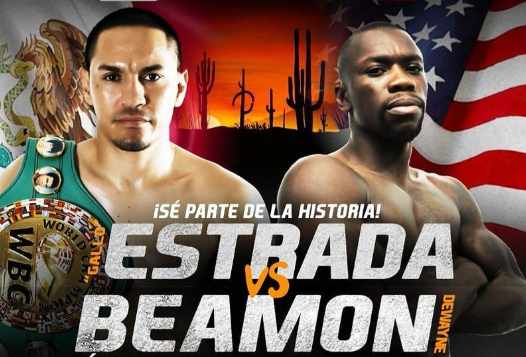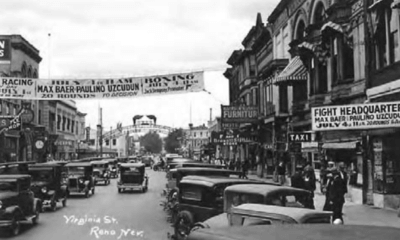Featured Articles
An Eclectic Undercard Girds Juan Francisco Estrada’s Hermosillo Homecoming

Juan Francisco Estrada: His Hermosillo Homecoming and an Eclectic Undercard
Eddie Hearn, the head of the boxing division of Matchroom Sport, the company founded by his father, sure does get around. Since entering into a joint venture with DAZN in May of last year, Hearn has widened his geographic scope. This weekend, Matchroom is in Hermosillo, Mexico, partnering with Mexican heavyweight Zanfer Promotions on a deep DAZN card headlined by a local man, WBC 115-pound title-holder Juan Francisco Estrada.
Estrada (39-3, 26 KOs) is widely considered the top fighter in his weight class. He’s 13-1 since losing on points to Roman “Chocolatito” Gonzalez who was then undefeated and climbing the list of the world’s top pound-for-pound fighters. The lone defeat was to Chocolatito’s conqueror, Srisaket Sor Rungvisai (aka Wisaksil Wangek), and Estrada avenged that setback in his last outing, winning the WBC belt to become a title-holder in a second weight division.
The challenger, Dewayne Beamon (16-1-1, 11 KOs), hails from Goldsboro, North Carolina. He had 11 of his first 12 fights in the Tar Heel State, the other in neighboring Virginia, and fought his last six fights in Mexico. He’s 34 years old.
Beamon certainly hasn’t done enough to warrant a shot at a world title and hailing from North Carolina is a knock against him. North Carolina cranks out about as many good pro boxers as North Dakota cranks out good pro basketball players, which is to say hardly any at all. In common with several other states, North Carolina has become a feeder lot, a place where boxers are fed soft touches to pad their records and make them palatable as opponents for pugilists higher-up in the food chain. But having said that, we have a nagging suspicion that Beamon will make things interesting.
Beamon excelled in football and basketball at a small college in Virginia that has since dropped its football program, impressive for a five-foot-four fellow whose playing weight was somewhere south of 140 pounds. The son of a minister, he came to boxing late because his parents were opposed to it and as an amateur he was good enough to advance to the National Golden Gloves tournament. His curious nickname, “Stop Running,” dates to his amateur days and was a nod to the fact that none of his opponents were willing to stay in the pocket and trade punches with him.
The aforementioned Sor Rungvisai is also under contract to Matchroom/DAZN. A win by Estrada is expected to propel him into a rubber match with the Thai. Their previous fights were highly entertaining and a third meeting would be welcomed with raves by serious boxing fans.
– – – –
Notable British boxers Liam “Beefy” Smith and Jono Carroll and hot heavyweight prospect Filip Hrgovic are also on the card.
Liverpool’s Smith, one of four fighting brothers (the youngest, Callum Smith, just may be the best 168-pound fighter in the world) has lost only twice in 30 starts, both coming in world title fights, the first with Canelo Alvarez and the second with Jaime Munguia. He is matched against Mexican veteran Mario Alberto Lozano (33-9, 24 KOs) who went the distance in a 10-round fight with Jermell Charlo in 2014.
Jono Carroll (16-1-1, 3 KOs) made a lot of new fans in his U.S. debut in March when he battled defending IBF 130-pound champion Tevin Farmer hammer-and-tongs in Farmer’s hometown of Philadelphia.
This was a match between two southpaws, neither of whom was known as a hard puncher. On paper, it figured to be boring, but au contraire it was a feisty squabble in which the combatants threw a combined 2,050 punches according to BoxRec, 1,227 by Carroll. When the smoke cleared, Farmer won a close but unanimous decision, after which he reportedly took Carroll along for a post-fight meal, a Philly cheesesteak, natch.
The heavily bearded Irishman, who made his pro debut in Australia, is an interesting character. It figures that he will have a less strenuous fight in Hermosillo where he is matched against Mexican journeyman Eleazer Valenzuela (20-11-4, 16 KOs).
Filip Hrgovic (8-0, 6 KOs) needs to be busier. Although he has a far stronger amateur background than fellow young guns Daniel Dubois and Efe Ajagba, they have surpassed him in terms of name recognition.
The six-foot-six Croatian, who trains in Miami, needed only 60 seconds to dispatch Gregory Corbin in his U.S. debut in May. On Saturday, he opposes Mario Heredia (16-6-1, 13 KOs) who stands 5-foot-10 and carried 275 pounds in his last fight against Samuel Peter in Atlantic City. He earned this assignment by defeating Peter, winning an 8-round split decision.
“After his countryman Andy Ruiz’s win and his win in his last fight against Samuel Peter, (Heredia) surely has the wind in his sails,” Hrgovic told a reporter for a Croatian paper.
Hrgovic will take the wind out of his sails.
For some folks, the 10-round junior welterweight contest between Shakhram Giyasov (8-0, 6 KOs) and Darlys Perez (34-4-2, 22 KOs) is the most intriguing match on the card.
Columbia’s Perez, a former interim WBA lightweight title-holder, has lost two of his last three, late stoppages at the hands of Luke Campbell and Maxim Dadashev, but before that he out-fought future super lightweight titlist Maurice Hooker in a bout that was confoundingly scored a draw. Perez is definitely a step up in class for the fast-rising Giyasov, a silver medalist for Uzbekistan at the 2016 Olympics.
Check out more boxing news on video at The Boxing Channel
To comment on this story in The Fight Forum CLICK HERE
-

 Featured Articles3 weeks ago
Featured Articles3 weeks agoAvila Perspective, Chap. 330: Matchroom in New York plus the Latest on Canelo-Crawford
-

 Featured Articles2 weeks ago
Featured Articles2 weeks agoVito Mielnicki Jr Whitewashes Kamil Gardzielik Before the Home Folks in Newark
-

 Featured Articles4 weeks ago
Featured Articles4 weeks agoOpetaia and Nakatani Crush Overmatched Foes, Capping Off a Wild Boxing Weekend
-

 Featured Articles3 weeks ago
Featured Articles3 weeks agoCatching Up with Clay Moyle Who Talks About His Massive Collection of Boxing Books
-

 Featured Articles4 weeks ago
Featured Articles4 weeks agoFabio Wardley Comes from Behind to KO Justis Huni
-

 Featured Articles2 weeks ago
Featured Articles2 weeks agoMore Medals for Hawaii’s Patricio Family at the USA Boxing Summer Festival
-

 Featured Articles3 weeks ago
Featured Articles3 weeks agoThe Shafting of Blair “The Flair” Cobbs, a Familiar Thread in the Cruelest Sport
-

 Featured Articles3 weeks ago
Featured Articles3 weeks agoRichardson Hitchins Batters and Stops George Kambosos at Madison Square Garden






















